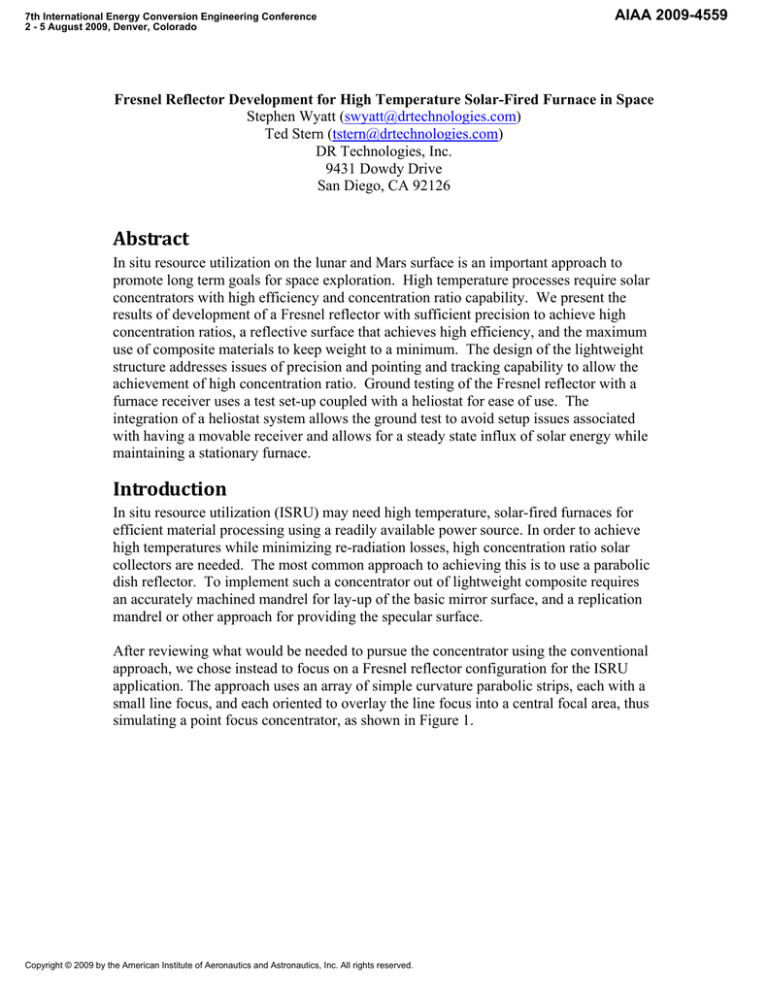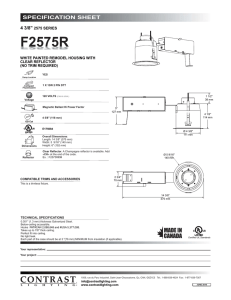
7th International Energy Conversion Engineering Conference
2 - 5 August 2009, Denver, Colorado
AIAA 2009-4559
Fresnel Reflector Development for High Temperature Solar-Fired Furnace in Space
Stephen Wyatt (swyatt@drtechnologies.com)
Ted Stern (tstern@drtechnologies.com)
DR Technologies, Inc.
9431 Dowdy Drive
San Diego, CA 92126
Abstract In situ resource utilization on the lunar and Mars surface is an important approach to
promote long term goals for space exploration. High temperature processes require solar
concentrators with high efficiency and concentration ratio capability. We present the
results of development of a Fresnel reflector with sufficient precision to achieve high
concentration ratios, a reflective surface that achieves high efficiency, and the maximum
use of composite materials to keep weight to a minimum. The design of the lightweight
structure addresses issues of precision and pointing and tracking capability to allow the
achievement of high concentration ratio. Ground testing of the Fresnel reflector with a
furnace receiver uses a test set-up coupled with a heliostat for ease of use. The
integration of a heliostat system allows the ground test to avoid setup issues associated
with having a movable receiver and allows for a steady state influx of solar energy while
maintaining a stationary furnace.
Introduction In situ resource utilization (ISRU) may need high temperature, solar-fired furnaces for
efficient material processing using a readily available power source. In order to achieve
high temperatures while minimizing re-radiation losses, high concentration ratio solar
collectors are needed. The most common approach to achieving this is to use a parabolic
dish reflector. To implement such a concentrator out of lightweight composite requires
an accurately machined mandrel for lay-up of the basic mirror surface, and a replication
mandrel or other approach for providing the specular surface.
After reviewing what would be needed to pursue the concentrator using the conventional
approach, we chose instead to focus on a Fresnel reflector configuration for the ISRU
application. The approach uses an array of simple curvature parabolic strips, each with a
small line focus, and each oriented to overlay the line focus into a central focal area, thus
simulating a point focus concentrator, as shown in Figure 1.
Copyright © 2009 by the American Institute of Aeronautics and Astronautics, Inc. All rights reserved.
(a) Model of a 1.5x1.5m Fresnel reflector using 60 strips
(b) Edge view showing individual strips
(c) A similar Fresnel point-focus concentrator from a prior program, focusing on the end of a light pipe
Figure 1. Fresnel reflector provides a point focus concentrator with an array of “short line
focus” strips, each oriented to superposition all of the line foci in a single spot.
This choice was based on several significant advantages. The array of simple curvature
strips can be fabricated without using an accurately machined mandrel as would be
needed for a parabaloidal dish, with each strip mounted on an accurately machined eggcrate structure. The specular surface needed on the strips can be readily implemented by
replicating the strips on a flat polished mandrel, or by bonding Optical Surface Reflectors
(OSR’s). Finally, without a requirement for a specific mandrel, the design of the Fresnel
reflector can be created, changed and implemented without long tooling delays.
Design and Analysis To synthesize the design of the concentrator, we used the SOLTRACE code provided by
the National Renewable Energy Laboratory. SOLTRACE is a powerful software tool for
synthesizing and analyzing solar concentrator configurations, and has the ability to
simulate the operation of a solar concentrator, including flux distributions at the focal
area arising from the practical considerations of the solar source collimation (see Figure
2), configurations with segmented reflectors (such as our Fresnel), reflector slope
tolerances, and pointing and tracking accuracy.
Figure 2. SOLTRACE models the solar intensity (arbitrary units) as a function of incoming
collimation (mrad) due to sun’s disk shape.
Using SOLTRACE, we set up a model that allows us to vary the width, length and
number of Fresnel strips in the concentrator, the focal length, and the overall aperture,
and then SOLTRACE determines by ray-tracing, the number and distribution of rays
falling within a selected aperture size. A typical result of the raytracing is shown in
Figure 3, which modeled a 1.5m X 1.5m reflector aperture comprising 60 strips focusing
on an aperture of 3.5cm diameter at a focal length of z=200cm. In the figure, the
concentrator vertex is at (0,0,0). The scale of the view in the figure shows a 4 cm cube
around (0,0,200) with the concentrator vertex 200 cm to the front left. The raytracing is
used by SOLTRACE to determine the flux distribution at the focal plane (see Figure 4)
and the resulting intercept efficiency.
Figure 3. Scatter plot of rays intersecting the 3.5cm diameter focal plane aperture of a
150X150cm Fresnel reflector with a focal length of 200cm (all axes in cm).
Figure 4. Flux distribution at the focal plane (z=200cm), which can be used to determine
maximum fluxes on the heat pipe end and intercept efficiency.
Using this raytracing analysis approach, we evaluated the tradeoff of intercept efficiency
with focal length with the results shown in Figure 5. We used these results to evaluate
achievable mass and accuracy and chose a focal length of 200cm, approximately
equivalent to an optimum F/d of ~1.2. Having determined the optimum focal length of
200cm, we introduced mirror errors into the model and evaluated the focal plane flux
distribution for a more realistic mirror having slope and specularity errors equivalent to
2mrad and 0.5mrad, respectively. The resulting flux distribution, shown in Figure 6,
indicates smearing of the rectangular flux distribution from Figure 4 into a more circular
flux distribution.
100%
90%
Intercept Efficiency
80%
70%
60%
50%
40%
30%
20%
10%
0%
50
100
150
200
225
250
300
400
500
800
Focal Length
Figure 5. Intercept efficiency as a function of focal length for an idealized reflector having an
aperture of 1.5 X 1.5m.
Figure 6. When practical mirror errors are introduced, the flux distribution smears into a more
circular profile.
Mirror Assembly and Strip Development We developed two approaches to fabricating the mirror strips. In both cases we used a
composite laminate of ultra-high modulus Graphite Fiber Reinforced Composite (GFRC)
having a thickness of 0.25mm (10mils) as the reflector surface. In one approach, The
mirror strip was mounted on a composite rib structure, as shown in Figure 7, while the
other approach used a sandwich structural support, as shown in Figure 8. Although the
composite rib approach would have lower mass, for the practical purpose of creating a
ground demonstration article, we decided to pursue the sandwich structure approach.
Figure 7. Implementation of Fresnel mirror on composite rib.
Figure 8. Alternative approach used a sandwich structure as support.
Assembly and Test After completion of the development of the mirror facet design, we focused on
developing a tool which we could use to both attach the mirror facet face-sheets to the
core to make the completed Fresnel mirror strips and to assemble and align the mirror
facets within the frame. The assembly and alignment tool shown in Figure 9 comprises a
syntactic foam structure which is numerically machined and verified within a 2-mil RMS
tolerance. The individually curved sections of the tool provide a means for bonding facesheets on to the ribs for each mirror facet, and then positioning each mirror facet into its
proper location and orientation, as shown in Figure 10, where it is fixed within a frame
(not shown).
Figure 9. Assembly and alignment tool.
Figure 10. Mirror facets are aligned on the tool and fixed in place. .
After assembling the mirror facets into the frame, we plan to test the assembly with a
heliostat and calorimeter, as shown in Figure 11. The integration of a heliostat system
allows the ground test to avoid setup issues associated with having a movable receiver,
avoids the issue of gravity sag on the reflector, and allows for a steady state influx of
solar energy while maintaining a stationary furnace or calorimeter.
Figure 11. The assembled Fresnel reflector, mounted into a frame and positioned vertically for
illumination using terrestrial sunlight and a heliostat.
Conclusions A Fresnel reflector can be designed for a lightweight, large aperture solar concentrator
that achieves high concentration ratio while avoiding the problems associated with
fabricating a parabolic dish. Individual mirror strips can be readily manufactured from
composite to achieve an accurate and lightweight mirror surface. The mirror strips can
be assembled into a frame structure using relatively inexpensive tooling and aligned to
achieve maximum concentration ratio.
Acknowledgments This work was sponsored in part by the NASA Glenn Research Center under a Small
Business Innovation Research Program. The authors would like to thank Al Hepp and
Kurt Sacksteder, Geoffrey Landis and Barry Hillard for their guidance and support.

